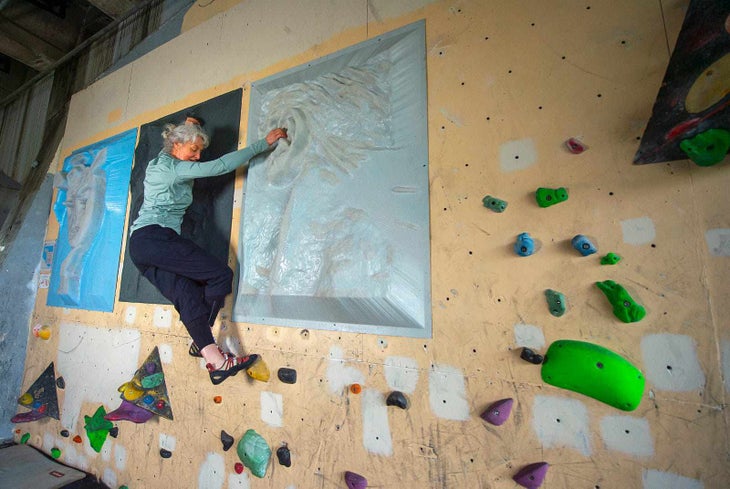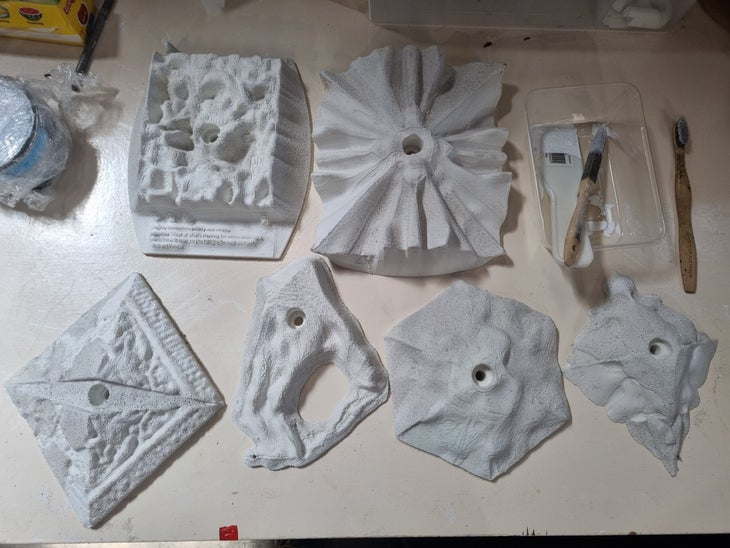Heading out the door? Read this article on the new Outside+ app available now on iOS devices for members! Download the app.
While Stu Beekmeyer was at home recovering from a life-altering and traumatic brain injury, he felt like he was “putting a solid dent in his couch.” The life-long climber was suddenly at a standstill, faced with an impossible choice: he could, in his own words, “sit at home and watch Netflix for two years,” or find a way to “regain his focus.” And after weeks of scrolling through the climbing-corner of Instagram, skipping past oversaturated sunset pics and flashy comp boulders, he came up with a way to reconnect with his sport—through art, through others, and through designing climbing holds fit for a museum.
His project, Bouldergeist, represents a groundbreaking endeavor that fuses bouldering and art, going beyond traditional gym holds to mimic the movement of outdoor climbing in an indoor setting. Climbing caught up with Beekmeyer to learn more.

Climbing: So what is Bouldergeist, and how did it start?
Beekmeyer: I think of Bouldergeist as art that climbs like rock. When I was a landscape architect, my entire business model was to try and steal public art budgets to put up climbing walls in public spaces. And I was looking for a way to go out and scan actual boulders to use as holds, and I couldn’t really afford to do it, so I scanned a head of lettuce. And I started looking at it and thinking: “There’s some seriously good climbing in this.” I don’t think climbers care what they are climbing as long as you can climb it and it climbs well—so why not climb a lettuce? Why not climb a painting?
Because I couldn’t climb for a year and a half, this project gave me a really nice connection with climbing, and the climbing world internationally, that I probably wouldn’t have gotten if I didn’t become sick—which is really, really ironic.
Climbing: Tell me about the business side of things. How is this project funded?
Beekmeyer: At the moment, I’m self-funding but in the next year will be looking for smart investment. Right now, the focus has been testing ideas and getting prototypes together. I’m about to launch the bouldering holds at Vertical Pro in Germany at the end of November with Banana Volumes and have the beginnings of a production partnership in Germany. Once we start getting the holds out, this idea is scalable between the gym, public sculpture and even the art gallery, so there’s lots of room to grow and to refresh.

Climbing: How do your holds differ from regular gym holds, and what can they add from a performance perspective?
Beekmeyer: With nature, we have to discover climbing. You have to go out and you gotta find the places that you’re projecting—and not all rocks are good for climbing. And, in the middle of all that, you’re trying to find one incredible line to the top. With artificial climbing, I see it more as choreography, like ballet, so ironically, the experience of what I’m making is actually more like climbing real rock—you have to search for the holds and challenge yourself to think and move differently.
Climbing: What’s it been like for you to see your vision start to come to life? How has the public response been?
Beekmeyer: It’s been incredible. I think people really engage with climbing art, not just the forms, but the subtleties of the brush strokes as well. I don’t want to sound like a hippy, but I think if you’re putting out something unique and creative the right people will respond. It’s like finding climbing partners, I guess—there’s a Zen to every partnership.
Climbing: What is your long-term vision for Bouldergeist?
Beekmeyer: I’d love to have climbable sculptures in big cities. One of my favorite things about climbing is the random people you meet on a constant basis, and who make you feel like the world’s a better place because you’ve just had this random chat. That’s the only thing I ever really wanted to bring into the discipline of landscape architecture, because as the world is getting more expensive, I just think public space is just really important, especially in cities, and I believe climbing should be a key part of that.
[This interview was lightly edited for clarity. —Ed.]
